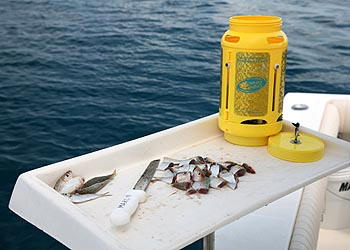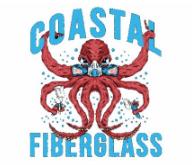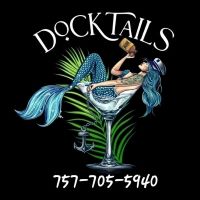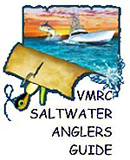Here are some tips for catching Cobia in the lower Chesapeake Bay and along the Virginia Beach oceanfront.
Very few inshore saltwater species offer the big fish thrill like the powerful cobia. Luckily for Mid Atlantic anglers, we get our share of this stealthy scavenger, with many large fish available. Last year was among one of the top years for cobia, with good numbers of fish, with many big fish topping 50-pounds. Cobia are actually found all over the globe, making it a well-known species everywhere. This wide distribution lends to its many names including ling, lemon fish, and crab-eater. Locally, they are fondly referred to by their brownish-color, as if they are wearing a brown suit. Following the temperate water conditions up the coast, cobia make their entrance into the Chesapeake Bay area quietly in early summer.
Cobia display an appearance exclusive to its own species. With a long, smooth frame and a broad, sloped forehead, the fish easily glides through the water in search of food. Fluid-like movements along with the long body shape of the cobia resembles that of a cruising shark, and is often confused with these completely un-related hunters. Cobia can grow to massive sizes of over 100 pounds, but even an average-sized fish of 20 to 30 pounds can offer an impressive skirmish, often manipulating even the most skillful angler on multiple guided tours around his own boat trying to keep up! Once defeated though, the quality table-fare afforded to the whole crew from one fish is well worth the sweat-provoking exercise. The state of Virginia offers attractive citation plaques for those anglers scoring with trophy-sized cobia over 55-pounds, or releasing fish over 50-inches.
Timing and Location
Once present around the bay area, cobia can show up most anywhere…often surprising anglers fishing for other species. While entering the bay, these fish become almost covert, cruising low in the water hunting for small fish, crabs, and eels. Acting as true scavengers, cobia will also lazily mirror turtles, skates, rays, and other carnivores during their travels, snapping up any leftovers along the way.
From early summer through July, cobia experts utilize the most effective method for targeting these sly beasts, chumming the shoals. Many shoals are available in and near the lower bay for this technique. Some of the more popular shoals for cobia squatting include the Eastern Shore shoals, the Grandview and Buckroe Beach areas of Hampton near the mouths of the lower bay rivers, and the Middle Grounds near the Chesapeake Bay Bridge tunnel.
Although most shoalers prefer to work their cobia spots during daylight hours, it is possible to catch these brown beasts after sunset. Other shoal scavengers such as red and black drum are also good possibilities while fishing these same areas, along with many time consuming trash fish, such as skates and small sharks. Once arriving to your shoal of choice, carefully search the bottom for a depth ranging somewhere between 8 to 20 feet for anchoring. Choose a location with plenty of distance between you and other boats, buoys, crab pots, and bridge structures. These fish are strong, and are known to make effortless long and unyielding runs.
Tackle
Cobia chumming requires basic equipment and tackle in the 30-pound class range. My preference is a combination consisting of a conventional style reel, such as Shimano’s TLD 15 or Torium 20, spooled with 30-pound test line paired up with a 6-7 foot live-bait or boat rod made for handling fish pushing over 60 pounds. A fish-finder rig works well for these bottom feeders, which is prepared by placing a sinker-slide and sinker above a stout barrel-swivel and tying on 2 to 4 foot of 50 to 80-pound monofilament leader material. A long leader helps keep the sinker from becoming an issue, or knocking about your fish, but makes casting difficult. Keep in mind, casting far distances is not usually required for cobia fishing on the shoals. Long leaders will also ensure your leader takes the brunt of the abuse, not your 30-pound test line, since skirmishes with these determined fish can lead to frayed lines. Adding a 3-4 foot segment of doubled line above your leader will add a little more protection against fraying or breakage. Using a 3-4 ounce egg sinker instead of a sinker slide will also offer a little better castablitiy. An extremely sharp 7/0 to 8/0 conventional offset hook, as opposed to circle hooks works best with cobia. These fish have extremely hard mouths, completely lined with tiny-sandpaper teeth…including their tongues; therefore a very strong hook with a razor-sharp point is requirement.
Baiting and Chumming
The cobia’s diet is diverse, allowing for many options for bait. Some of the more popular cobia enticers include fresh menhaden, bluefish, crabs, live eels, and live spot and croaker. My favorite choice is fresh menhaden, which can be purchased in bulk or in flats at local tackle shops, but be sure to call ahead to verify they have plenty. Whatever your choice of bait, take along an ample supply, extensive chumming will attract undesirables from all over, working through your bait. Store bought chum usually consists of a mixture of mostly ground menhaden frozen in bulk containers or bags. Placing this frigid concoction over the side of your boat in the warmer water allows the mass to melt, slowly releasing a very oily slick, which can be seen on the surface for many miles. Two large buckets of chum are usually just enough. Supplementing your chum slick with chunks of bunker can also prove helpful. Toss the chunks up current near the boat. Ensure your chunks are not frozen or they will float instead of sink, and thrifty seagulls will happily take those floaters off your hands. Although frozen chum provides a very good attractant, I have found that using a chumming device gives an edge over the frozen variety. The ability to disperse fresh chum quickly can make the difference between a good day and a great day on the shoals. My favorite chumming device is the popular Chum Churn (www.chumchurn.com), which contains very sharp blades and creates a commotion during the cutting process which supposedly attracts the curious cobia. Keep in mind, when initially searching the shoals for an optimal cobia spot, be mindful to avoid other boat’s chum slicks, you will certainly hear some choice words yelled in your direction if you forget.
Baiting up
To prepare menhaden as bait, cut off the head and tail, and divide the remaining body into about 3 to 4 inch segments, guts and all. Work the hook through the body portions of the bunker, ensuring the barb of the hook is exposed, and that the shank lays flat against the bait. The tail can ad to your chum slick, but use the head as bait if the bait-stealers are out-in-force. If adding eels to the mix, using a dry towel is helpful to hold the eel while hooking it through the nose, or the tail. Many prefer to hook the eel through the tail to decrease its knotting around your line.
Check the baits often and keep them as fresh as possible, since plenty of critters will sample your offerings. Because your uninvited visitors may include intimidating sharks, large cow-nosed rays, and giant sea rays, take along plenty of extra hooks. It is already frustrating to spend quality fishing time untangling crossed lines from these aggressive bandits, but lost hooks with insufficient back-up, will certainly shorten a shoal trip in a hurry.
Setting up
Once anchored in position, begin by placing your chum over the side to get your slick started as you prepare your bait and set up. If you are using a chumming device, be sure to utilize the device often throughout your trip.
Set out four baited rods by casting two of the baits out away from the boat, while dropping the other two baits on the bottom, right behind the boat. If you are using live bait in the mix, use the outside rods for these baits. Put the rods in holders, back off the drag, and turn on the clicker so that the current does not pull the line. This gives the cobia the opportunity to grab the bait and begin to swallow it before he feels any resistance. Once the clicker sounds, quickly pick up the rod, turn off the clicker, employ the drag and set the hook with force enough to engage the fish’s extremely tough mouth. Verify your drag, and hold on!
Fighting and Landing
Once hooked into a robust cobia, prepare for some agile footwork while countering a tricky fighter, with lengthy runs, quick turns, and even an occasional leap. These fish are very strong and determined, and will certainly hold their ground, so stand-offs between fish and angler are not uncommon.
Never make the mistake of attempting to gaff these uncontrollable fish. Stabbing a cobia is a bad idea; a crazed cobia spooked from a gaffing attempt can leave you fishless, gaffless, or worse. Instead, stand by with a very large net for landing these sturdy beasts. Have two people heave the fish over the side while holding the netting, not the rim, or the net will bend. Swiftly deliver the cobia to the fish box, or at the minimum leave it in the net until it is calm. Once boated, the scuffle can rekindle, and even a small cobia is very powerful, and sports a row of sharp, depressible spines behind its head. This is a tough lesson, but broken equipment, damaged boats, and injured body parts from an uncontrollable cobia loose in the boat are common.
Exhibiting a little patience and planning while on your cobia quest will reward you with an incredible fighting experience paired with a prize for the palate well worth bearing the hot summer heat.











 Views Last 7 days : 2012
Views Last 7 days : 2012 Views Last 30 days : 6854
Views Last 30 days : 6854